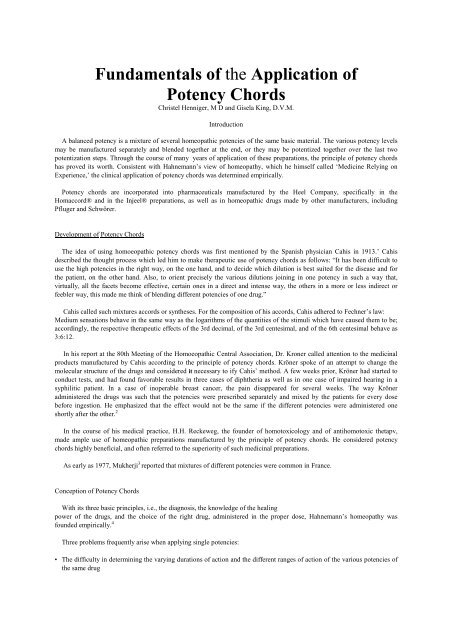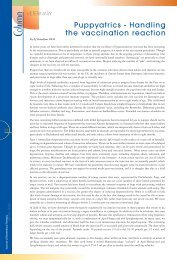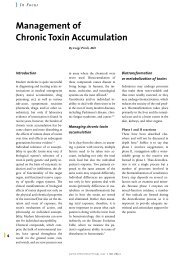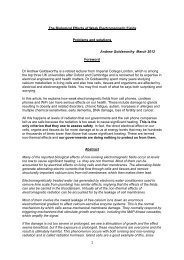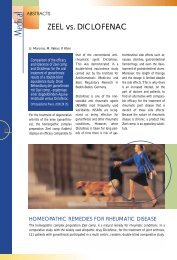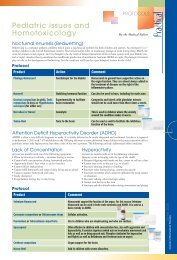Potency Chords - Bio Pathica Ltd
Potency Chords - Bio Pathica Ltd
Potency Chords - Bio Pathica Ltd
You also want an ePaper? Increase the reach of your titles
YUMPU automatically turns print PDFs into web optimized ePapers that Google loves.
Fundamentals of the Application of<strong>Potency</strong> <strong>Chords</strong>Christel Henniger, M D and Gisela King, D.V.M.IntroductionA balanced potency is a mixture of several homeopathic potencies of the same basic material. The various potency levelsmay be manufactured separately and blended together at the end, or they may be potentized together over the last twopotentization steps. Through the course of many . years of application of these preparations, the principle of potency chordshas proved its worth. Consistent with Hahnemann’s view of homeopathy, which he himself called ‘Medicine Relying onExperience,’ the clinical application of potency chords was determined empirically.<strong>Potency</strong> chords are incorporated into pharmaceuticals manufactured by the Heel Company, specifically in theHomaccord® and in the Injeel® preparations, as well as in homeopathic drugs made by other manufacturers, includingPfluger and Schwörer.Development of <strong>Potency</strong> <strong>Chords</strong>The idea of using homoeopathic potency chords was first mentioned by the Spanish physician Cahis in 1913.’ Cahisdescribed the thought process which led him to make therapeutic use of potency chords as follows: “It has been difficult touse the high potencies in the right way, on the one hand, and to decide which dilution is best suited for the disease and forthe patient, on the other hand. Also, to orient precisely the various dilutions joining in one potency in such a way that,virtually, all the facets become effective, certain ones in a direct and intense way, the others in a more or less indirect orfeebler way, this made me think of blending different potencies of one drug.”Cahis called such mixtures accords or syntheses. For the composition of his accords, Cahis adhered to Fechner’s law:Medium sensations behave in the same way as the logarithms of the quantities of the stimuli which have caused them to be;accordingly, the respective therapeutic effects of the 3rd decimal, of the 3rd centesimal, and of the 6th centesimal behave as3:6:12.In his report at the 80th Meeting of the Homoeopathic Central Association, Dr. Kroner called attention to the medicinalproducts manufactured by Cahis according to the principle of potency chords. Kröner spoke of an attempt to change themolecular structure of the drugs and considered it necessary to ify Cahis’ method. A few weeks prior, Kröner had started toconduct tests, and had found favorable results in three cases of diphtheria as well as in one case of impaired hearing in asyphilitic patient. In a case of inoperable breast cancer, the pain disappeared for several weeks. The way Kröneradministered the drugs was such that the potencies were prescribed separately and mixed by the patients for every dosebefore ingestion. He emphasized that the effect would not be the same if the different potencies were administered oneshortly after the other. 2In the course of his medical practice, H.H. Reckeweg, the founder of homotoxicology and of antihomotoxic thetapv,made ample use of homeopathic preparations manufactured by the principle of potency chords. He considered potencychords highly beneficial, and often referred to the superiority of such medicinal preparations.As early as 1977, Mukherji 3 reported that mixtures of different potencies were common in France.Conception of <strong>Potency</strong> <strong>Chords</strong>With its three basic principles, i.e., the diagnosis, the knowledge of the healingpower of the drugs, and the choice of the right drug, administered in the proper dose, Hahnemann’s homeopathy wasfounded empirically. 4Three problems frequently arise when applying single potencies:• The difficulty in determining the varying durations of action and the different ranges of action of the various potencies ofthe same drug
three different potencies of one and the same basic material to manufacture a remedy, e.g., 6X, 1 5X, 30X, and you may bequite sure that the right potency is among them.” So to Eichsteller, too, potency chords are an empirically discoveredsolution to the question regarding the appropriate level of dilution.An important consideration with regard to the potency chords was whether, if mixed, the various potencies of a substancemight not mutually interfere with each other’s action. In this context, Cahis stated he was sure that it was possible to dissolvein a glass of water, which included a few milligrams 0 f sodium chloride, the 30th centesimal of muriatic sodium, without theformer impairing the therapeutic effect of the latter.Regarding the question as to whether potency chords will actually achieve in practice what is expected theoretically;Cahis expressed the following opinion:“I think so. One may be sure that the action is a milder one, the individual doses may be repeated more frequently, and, if itis necessary, as it often happens, they may be given over a prolonged period of time.” Among other cases, Cahis gave anaccount of one cyst and three carcinomas being cured with his remedies.J ulian~, too, reported on the application of mixtures of various potencies of one and the same homeopathic remedy,specifically the nosodes. He quoted in support his forerunners, such as Cahis, Castueil, Barishac, Fortier-Bernoville, andothers, that the action of the potency chords is “faster, of greater intensity, longer-lasting, and less connected withadverse drug reactions.” Fortier Bernoville, too, emphasized that the mixture acts in a fast, intensive, and long-lasting way.The Problem of Initial Aggravation of the Patient’s ConditionIn homeopathy, initial deterioration in the patient’s condition is a reaction of the patient to the appropriate remedy (simile).This aggravation is usually either a ‘drug-induced, iatrogenic disease taking possession of the organism’ or a ‘clearingouttaking place in the organism.’ While the symptoms change for the worse, the patient’s general state of health improves.There is one notable exception. According to Kent, “Where no alteration of tissue, hence no final results of a disease, mustbe found, healing may be expected to take place without any serious deterioration in the patient’s condinon.Hence the physician has to distinguish between acute and chronic diseases or phases of a disease. A violent change ofsymptoms for the worse is indicative of the end stages of a serious disease, late sequelae of long-lasting development. So theinitial deterioration in the patient’s condition is valuable from the diagnostic point of view while it is undesired from thetherapeutic point of view, as it may force discontinuance of the treatment with the appropriate remedy.Meager’ 0 made the following observation regarding sulphur: “With high potencies, too, one may experience an initialdeterioration in the patient’s condition.” According to Kent, an explanation of this is the presence of alterations of tissueoccurring in case of chronic diseases.Else~vhere, Meager, however, considered essential and necessary the application of high poteneies: “Being stimulants ofreactions, high potencies are always to be preferred in individual doses.” He even xvent so far as to warn that, “giving toomany’ doses of low potencies, one may spoil a course of treatment.Reckeweg was also aware of this risk when he pointed out with regard to the mixing of low and high potencies that,“through the simultaneous administranon of high potencies, any adverse drug reactions that might be produced by lowpotencies will, at the same time, be slightly mitigated or decreased through the reversal effect of the high potencies.” Theterm ‘reversal effect’ covers the idea of the interference of similar vibrational waves. Jacobi~ mentioned a large number ofadditional methods of furnishing proof of the action and efficacy of high potencieS.Not~vithstanding theoretical considerations, practical clinical experience confirmed what Hahnemann observed: 7“However, if we leave aside the crude medicinal substances and have a look at the potencies around 30C, we observe thatthe latter produce a milder effect, but a more intensive healing action. The smaller the dose of the homeopathic drug, theslighter is the deterioration in the patient’s condition, and the briefer the duration of such deterioration.”Reckeweg’s experience regarding the calming or preventing of excessive healing reactions by adding high potencies tothe potency chords was gained in the course of his clinical activity as a general practitioner and constitutes the furtherdevelopment of the findings of Hahnemann which are quoted above.Reckeweg repeatedly referred to the calming effect potency chords had with regard to a possible initial deterioration inthe patient’s condition. “Owing to the high and maximum potencies included in the remedial mixture, any possible initialdeterioration in the patient’s condition is calmed. Therefore, after applying the Homaccord~, practically no initialdeterioration is observed in the patient’s condition, or, if observed at all, it occurs very rarely~”
Reckeweg” particularly emphasized the role the high potencies play in the range of action of potency chords:“Moreover, it appears that, adding high potencies to the ampule preparations, Injeels®, etc., a calming of excessive healingreactions will be achieved.” Reckeweg defined this as follows:’ 2 “For the principle of potency chords, the leading idea is thatdifferent potencies will reach different defense systems and that, through the simultaneous administration of high potencies,any adverse drug reactions that might be produced by low potencies will, at the same time, be slightly mitigated or decreasedthrough the reversal effect of the high potencies.”In addition to their beneficial effects produced on excessive healing reactions and on the prolongation or intensification ofthe desired action, there are other reasons which favor of the use of potency chords.Scientific Proof of ActionJunker reported on the effect extremely diluted substances produce on paramecia and on the effect extreme levels ofpotentiation have on organisms,’ 3 ’ 4 summarizing as follows: “If one continues diluting a substance (atropine, caffeine,orange juice, lemon juice) over and over again, uses those different strongly diluted solutions to grow paramecia, andclosely controls the paramecia’s reproduction, one will not, with a given dilution, reach the limit of the efficacy of thatsubstance, as might be expected a priori. On the contrary, in certain concentrations (e.g., around 1:1012 up to an inhibitedreproduction, in comparison with the control dilutions, will occur, whereas the intervening dilutions will show an increase inreproduction. So, if one represents the findings graphically, one will have a curve which, in fact, does not drop down to anindifference point or rise in a defined way. On the contrary, the result is a curve which, in its entire course, shows minimaand maxima which alternate at defined spots.” Of particular interest, too, are Junker’s tests with potency chords, in which theeffects of two series accumulated in a way as if two sound waves or light waves were summed up to the following result:minimum + minimum = great minimum, or minimum + maximum = 0. The result obtained was the same as if one had displacedby a defined distance between one potency and another the curves of two series produced in dependently from each other,and added them together, so to speak.A particularly impressive proof of the superior efficacy of homeopathic potency chords of phosphorus, as compared tothat of the respective single potencmcs, was furnished by Gomez.’ 5 In an experimental study, he verified the effects that maybe produced in mice in which a liver intoxication had, been previously induced with tetrachloromethane through theadministration of borneopathic dilutions of phosphorus. The action tested ~~‘as that of the ~on~es lOX, 30X, 200X, and1000X of phosphorus, as well as that of the balanced potency one obtains by mixing equal<strong>Bio</strong>medical Therapy / Vol. XVI I No. 11998 149


